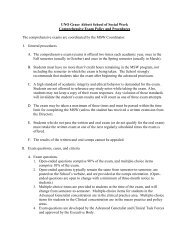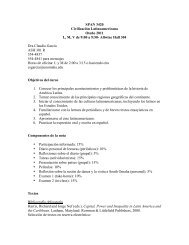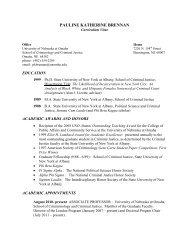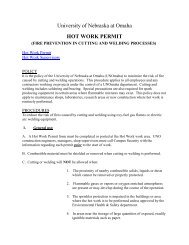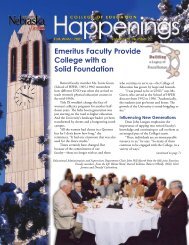Vegetative Morphology
Vegetative Morphology
Vegetative Morphology
Create successful ePaper yourself
Turn your PDF publications into a flip-book with our unique Google optimized e-Paper software.
<strong>Vegetative</strong><br />
<strong>Morphology</strong> I<br />
Lichen<br />
Growth<br />
Forms
Lichen Growth Forms<br />
•Crustose<br />
• Squamulose<br />
• Foliose<br />
• Umbilicate<br />
• Fruticose<br />
• Gelatinous
Evolution of Growth Forms<br />
• These lichen growth forms do not<br />
represent taxonomic groups<br />
– For example: all “trees” and “shrubs” are not<br />
related (although they have the same growth form)<br />
– Thus all “fruticose” lichens are not related. The<br />
fruticose growth form has evolved several times in<br />
different groups (families)<br />
• Growth forms (within one group) probably<br />
arose: crustose foliose fruticose
Crustose Lichens<br />
• Tightly attached to the substrate and<br />
considered to be the most primitive<br />
growth form, most species being<br />
epilithic or epiphloeodic<br />
– Subtypes include: powdery, endolithic,<br />
endophloeodic, lobate, effigurate<br />
– Some taxa may produce a distinct,<br />
marginal hypothallus (prothallus)
Crustose<br />
Lichens (cont.)<br />
• Thallus structure may<br />
be homiomerous<br />
(unstratified) or<br />
heteromerous<br />
(stratified-usually<br />
only with a cortex<br />
and medulla)
Crustose Lichens (cont.)<br />
Lecanora (epiphloeodic)<br />
Acarospora (epilithic)
More Crustose Lichens<br />
Haematomma<br />
Porpidia
Crustose Lichens (cont.)<br />
Crustose lichen<br />
(Lecanora) with<br />
an effigurate<br />
margin
Squamulose Lichens<br />
• Thallus composed of individual, tiny<br />
lobes (areolae) which may be partially<br />
free from the substrate<br />
• Often described as overlapping or<br />
scale-like<br />
• If these “squamules” are attached at a<br />
single point, the growth form is often<br />
called peltate
Squamulose Growth Form<br />
Psora with reproductive apothecia
Foliose Lichens<br />
• Leaf-like, flat with lobes (lacinae) and<br />
attached to the substrate usually with<br />
rhizines<br />
• May be homiomerous, heteromerous, or<br />
gelatinous<br />
• Heteromerous forms with upper cortex,<br />
medulla and lower cortex<br />
• Great diversity and common in most<br />
environments
Foliose Lichen Section<br />
rhizine
Upper Cortex<br />
Medulla<br />
Lower Cortex<br />
SEM Section of a<br />
Foliose Thallus
Foliose Lichens<br />
Peltigera<br />
Melanelia
More Foliose Lichens<br />
Hypogymnia<br />
Parmotrema
Umbilicate Lichens<br />
• A foliose thallus<br />
attached by a<br />
single point (an<br />
umbilicus)<br />
• Occur on rocks,<br />
both acidic and<br />
basic substrates<br />
Umbilicaria
Fruticose Lichens<br />
• Usually described as hair-like, shrubby,<br />
or pendulous species with rounded or<br />
flattened lobes<br />
• Some taxa develop a two-fold thallus<br />
(thallus verticalis and thallus<br />
horizontalis)<br />
– The erect portion is often called a podetium or<br />
pseudopodetium<br />
– The horizontal portion is often crustose or<br />
squamulose)
Fruticose Lichens (cont.)<br />
• Many fruticose<br />
species are adapted<br />
for the acquisition of<br />
water from the<br />
atmosphere<br />
• Many taxa have a<br />
“radial” symmetry in<br />
section
Fruticose Lichens<br />
Letharia<br />
Usnea
More Fruticose Lichens<br />
Cetraria Cladonia
Gelatinous Lichens<br />
• Thalli usually contain<br />
cyanobacteria<br />
• Often dark blue-green,<br />
brown, or black in color<br />
• Texture (when wet) of<br />
“old Jello”<br />
• Two most common<br />
genera are Collema and<br />
Leptogium<br />
Collema
Next ……..<br />
<strong>Vegetative</strong> <strong>Morphology</strong> II:<br />
Anatomical Structures<br />
of Lichen Thalli








